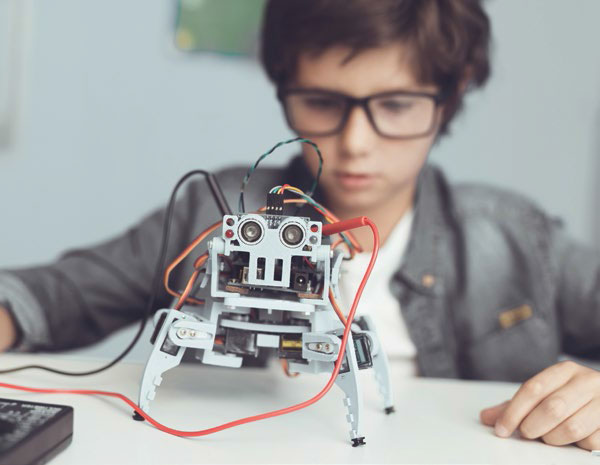Top 10 K–12 Educational Technology Trends

While “trendy” ideas and products come and go, many of these influential concepts seem likely to continue to shape edtech for many years to come. Some of them are still emerging, and some of them are controversial, but they all have great potential for teaching and learning. Here’s a roundup of today’s top edtech trends:
1 1:1 Devices—This trend seems to continue to expand. It depends largely on a school or district’s ability to fund the initiative. The idea of having a device for every student is a highly desirable goal for most, and this trend will likely continue for years to come as schools gradually build their programs until they reach 1:1 status.
2 Mobile Devices—Mobile devices in education can be controversial. Proper implementation and monitoring are essential to ensure a beneficial learning experience. Some benefits of mobile devices include the ability to view textbooks, research, participate in Internet-based class assignments, and create media-rich projects. Schools often have to address issues of equality and funding to ensure that all students, regardless of economic status, have access to a mobile device in the classroom so no one is disadvantaged.
3 Wearable Technology—Wearable technology is an up-and-coming trend in edtech. Wearable technology covers a wide range of items—from assistive technology for students with disabilities to devices to encourage motivation and participation. One way this trend is being implemented in K–12 education is with wearable devices such as watches, which a teacher can use to discretely notify or message students in class who may be off task, or to provide encouragement or praise for great work. This is particularly beneficial for students who may be shy or who may not like to be acknowledged in front of the entire class. The biggest barrier to this trend will likely be the cost of equipping an entire school or class with their own wearable technology.

4 Cloud Computing—Cloud computing is a trend that reduces many frustrations with computing. The ability to save something in the cloud, that can be shared and modified from anywhere at any time, has proven to be extremely useful. Gone are the days of creating multiple versions of a document every time it’s saved, or saving important work to a flash drive that must be taken everywhere and is at risk of being left, stolen, or lost.

5 Collaborative Computing—This trend is closely linked to cloud computing. The ability to collaborate on writing assignments, presentations, spreadsheets, etc. has proven to be an invaluable asset in K–12 education. Students can work both synchronously and asynchronously on the same item, and this is an advantage in many curricular areas and encourages group work. It is also beneficial that, with many collaborative computing environments, the teacher can review student work as it progresses to monitor when the work is getting done and who is contributing what to an overall project.

6 Robotics—Robots will likely continue trending in the K–12 environment. From Nao robots down to Cubetto and Ozobots, there are many ways to integrate robotics at varying price points. Premade robots can serve a specific purpose, but a more in-depth learning experience can arguably be had when students create robots to serve a specific purpose. Robots can be expensive, but they can also be built with spare parts and recovered or donated items. This provides diverse possibilities for robotics in K–12 education.
Tools and ideas to transform education. Sign up below.

7 IoT—Internet of Things (IoT) encompasses a wide variety of technologies, from auto-starting a car with an app to adjusting a thermostat over a wifi connection. It’s anticipated that this trend will continue to grow in edtech. The possibilities for IoT in K–12 education are endless. IoT can be integrated, for example, in the way content and textbooks are utilized, in how writing and notetaking are done, and in security features that a school or classroom can implement for student safety. The security aspect may raise controversy because there are privacy concerns connected to the ability to track students’ locations in school.
8 Augmented Reality—AR seems to be an often overlooked, or underrated, trend. While there are many instances where AR can be used simply as a gimmick, applications such as HP Reveal have near-limitless uses and could be used in any curricular subject to integrate technology and make for a richer educational experience.
9 Game-Based Learning—Game-based learning will continue to be a significant trend in K–12 education. From the days of playing PowerPoint Jeopardy for test reviews to app-based game creation applications, integrating games, technology, and education will continue to be a popular approach. There are limitless possibilities for game-based learning in education. From home-brewed games to store-bought prepackaged items, all offer benefits to education. Some examples include Bloxels, which utilizes an app on a tablet or phone to capture a physical game board that students can manipulate to create characters and layouts that are playable virtually on the tablet app. Another example, which incorporates many trends, is the game-based environment of many of the Hour of Code and Code.org activities to teach computational thinking concepts to K–12 students.
10 STEAM/STEM—The STEM or STEAM trend is not likely to be going anywhere anytime soon. A push to help students prepare to fill anticipated jobs in STEM fields is driving this trend. Most of the skills required for success in STEM learning are skills that can be used to solve problems in many other areas. Many other trends, such as makerspaces, could be combined with, and fall into, the STEM category. Anything associated with STEM education, from 3D printing and graphic design to engineering and coding, seems likely to continue to be a trend in K–12 education for the foreseeable future.
Steven Lahullier is an elementary school technology teacher at the Robert Gordon School in Roselle Park (NJ) and doctoral candidate in the Educational Technology Leadership program at New Jersey City University.
